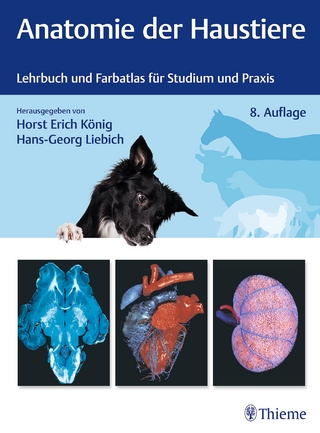
Dyce, Sack, and Wensing's Textbook of Veterinary Anatomy
Saunders (Verlag)
978-0-323-44264-0 (ISBN)
Comprehensive coverage of a multitude of species (dogs, cats, birds, horses, cows, pigs, sheep, goats, and now camelids) provides comparative anatomic information all in one resource.
Focuses on essential anatomy of each species, making this text ideal for any veterinary school curriculum that is covering the same amount of material in a reduced number of hours for course completion.
Clinical cases throughout relate actual cases to the study of anatomy to increase your understanding of how patients will present in practice.
Evolve site for students and instructors with a test bank, sample flash cards, and an image collection reinforces your understanding of veterinary anatomy - and helps you prepare for the NAVLE board exam.
Content is logically organized into two main sections - a general introduction to mammalian anatomy and a region-specific breakdown - to make studying more efficient and ensure greater understanding.
Flash cards and coloring book support the text and give you the opportunity to study anatomy in different ways to increase retention of what you have learned.
NEW and EXPANDED! New and updated diagrams further illustrate the anatomic structure and function of each species to facilitate comprehension of bodily functions, presenting the closest thing possible to an actual "hands-on" clinical experience.
EXPANDED! A 500-question Test Bank, designed for optimal NAVLE board exam preparation, lets you practice answering board-type questions.
UPDATED! New information on the anatomy of camelids, a species that is gaining importance in farm animal practice, provides an overview of the camelid anatomy and highlights any major differences compared to other species.
Info to be populated in this space Dr. Baljit Singh is a highly accomplished researcher, educator and administrator in the field of veterinary medicine, with specific expertise in lung biology and anatomy. He joined the University of Calgary Faculty of Veterinary Medicine in September 2016, after serving as Associate Dean of Research at the Western College of Veterinary Medicine at the University of Saskatchewan since 2011. Dr. Singh's formal education includes a Bachelor of Veterinary Science and Animal Husbandry (BVSc and AH) and Master of Veterinary Science (MVSc) from Punjab Agricultural University in Punjab; a PhD from the University of Guelph; post-doctoral training at Texas A&M University and Columbia University, New York; and he completed licensing requirements set by the Canadian Veterinary Medical Association (CVMA) and American Veterinary Medical Association (AVMA) for international veterinary graduates. Dr. Singh has received the 3M National Teaching Fellowship, the University of Saskatchewan's Provost's Prize for Innovative Practice of Teaching and Learning, University of Saskatchewan Master Teacher Award, and the Carl J. Norden Distinguished Teacher Award. He has also received the Outstanding Veterinary Anatomist Award from the American Association of Veterinary Anatomists, as well as the Pfizer Award for Research Excellence. In 2013 he was named a fellow of the American Association of Anatomists. Dr. Singh's research has focused on cell and molecular biology of lung inflammation. He is the author or co-author of more than 90 peer-reviewed journal articles and books and has supervised the research training of more than 80 undergraduate, graduate and postdoctoral students.
Part 1: General Anatomy 1. Some Basic Facts and Concepts 2. The Locomotor Apparatus 3. The Digestive Apparatus 4. The Respiratory Apparatus 5. The Urogenital Apparatus 6. The Endocrine Glands 7. The Cardiovascular System 8. The Nervous System 9. The Sense Organs 10. The Common Integument
Part 2: Dogs and Cats 11. The Head and Ventral Neck of the Dog and Cat 12. The Neck, Back, and Vertebral Column of the Dog and Cat 13. The Thorax of the Dog and Cat 14. The Abdomen of the Dog and Cat 15. The Pelvis and Reproductive Organs of the Dog and Cat 16. The Forelimb of the Dog and Cat 17. The Hindlimb of the Dog and Cat
Part 3: Horses 18. The Head and Ventral Neck of the Horse 19. The Neck, Back and Vertebral Column of the Horse 20. The Thorax of the Horse 21. The Abdomen of the Horse 22. The Pelvis and Reproductive Organs of the Horse 23. The Forelimb of the Horse 24. The Hindlimb of the Horse
Part 4: Ruminants 25. The Head and Ventral Neck of the Ruminant 26. The Neck, Back, and Vertebral Column of the Ruminant 27. The Thorax of the Ruminant 28. The Abdomen of the Ruminant 29. The Pelvis and Reproductive Organs of the Ruminant 30. The Forelimb of the Ruminant 31. The Hindlimb of the Ruminant
Part 5: Pigs 32. The Head and Neck of the Pig 33. The Vertebral Column, Back, and Thorax of the Pig 34. The Abdomen of the Pig 35. The Pelvis and Reproductive Organs of the Pig 36. The Limbs of the Pig
Part 6: Birds and Camelids 37. Anatomy of the Bird 38. Clinical Anatomy of Llamas and Alpacas
| Erscheinungsdatum | 10.07.2017 |
|---|---|
| Zusatzinfo | Approx. 1540 illustrations (1500 in full color); Illustrations |
| Verlagsort | Philadelphia |
| Sprache | englisch |
| Maße | 216 x 276 mm |
| Gewicht | 2400 g |
| Themenwelt | Veterinärmedizin ► Vorklinik ► Anatomie |
| Veterinärmedizin ► Kleintier | |
| Veterinärmedizin ► Großtier | |
| ISBN-10 | 0-323-44264-1 / 0323442641 |
| ISBN-13 | 978-0-323-44264-0 / 9780323442640 |
| Zustand | Neuware |
| Informationen gemäß Produktsicherheitsverordnung (GPSR) | |
| Haben Sie eine Frage zum Produkt? |
aus dem Bereich



